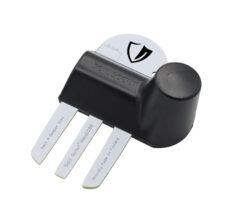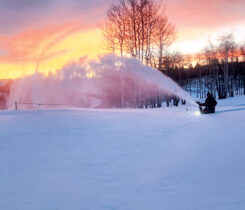How to maximize your soil moisture sensors
To reap as many benefits from their soil moisture sensors as possible, Grady Miller, Ph.D., professor and Extension turf specialist in the crop and soil sciences department at North Carolina State University, advises superintendents to utilize them frequently.

Grady Miller
In doing so, Miller says superintendents will become more comfortable using them, learning the various ins and outs and the measurements they should typically expect with each type of soil profile they evaluate at their courses. Not to mention, they’ll also learn exactly how to utilize the sensor to collect the data needed to make key decisions.
“For example, superintendents should consider taking readings several hours after a soaking rain in order to receive a field capacity reading,” Miller says. “By acquiring a field capacity reading, they’ll be able to fully understand their courses’ upper soil moisture limits. On the other hand, to determine their lower soil moisture limits, they should obtain data regarding slightly stressed turfgrass.”
The more you know
Miller encourages superintendents to measure as many areas on greens as possible to get a good range of readings for each area.
“As a result, they’ll learn their data range in a variety of turf areas, from well-watered to stressed areas,” he says.
Of equal importance, superintendents should always collect soil moisture at approximately the same depth as the majority of the turfgrass root systems, which is generally about 4 inches.
Depths may be shallower on greens. Upon collecting this data, superintendents can then determine the field capacities and stress on the course. Once they verify these findings, they can then use such data singularly or in conjunction with evapotranspiration (ET) calculations.
“Singular usage can be helpful if superintendents have areas that may require hand watering,” Miller says. “By utilizing soil moisture sensors singularly — as turf health and water conservation tools — their courses’ surfaces will likely remain more uniform not only in appearance but from an overall health standpoint.”
Groundworx

Tim Barrier, CGCS
Tim Barrier, CGCS
Consultant
Groundworx delivers efficiencies by establishing real-time thresholds. Therefore, superintendents can apply the exact amount of water that’s necessary to maximize conservation — without sacrificing turf health. As temperatures rise, it’s critical to remove the guesswork about what is occurring at the root zone. Our device is intuitive. It provides a snapshot of how much water is available, as well as where it is essential, every 10 minutes. An “inventory” of available moisture is always visible on the dashboard or app. As a result, the water holding capacities of soils will emerge in the superintendent’s data, and they see firsthand where any waste is occurring. Heavy clay soils hold moisture longer than sandier soils, and they stretch superintendents’ windows on timely irrigation applications. Sandier soil profiles will spike with water applications, fall rapidly and predictably drain water. Consequently, water management, particularly at the root zone, becomes a part of the course’s culture.
Soil Scout

Adam Sedgwick
Adam Sedgwick
VP, international sales
Superintendents can get the most out of their soil moisture sensors by utilizing all of the data they collect to influence their timings for fertilizer and pesticide inputs. By using Soil Scout’s soil moisture data alone, superintendents can optimize their irrigation practices and achieve considerable savings — upwards of 25 percent — in water usage. This is significant since, as an industry, we’re all guilty of overwatering. Oftentimes, superintendents overlook moisture in the profiles of their greens, leading to pollution problems. When the profiles of greens (effectively just giant drains) are too wet, as fertilizer releases and becomes available, it runs straight through the profiles, resulting in waste. By utilizing the data they collect from soil sensors while also managing moisture better in the profiles under their greens, superintendents will be able to use their fertilizers more efficiently, leading to savings of 12 to 17 percent in nutrient availability — without the risk of pollution issues.
Spiio

Dave Latshaw
Dave Latshaw
National sales representative
Superintendents can utilize Spiio soil moisture sensors to their full advantage by implementing several of them per hole. In doing so, they’ll have a complete picture of what’s occurring beneath their soil, thereby enabling them to make more informed decisions on how to irrigate. As a result, they’ll not only improve their courses’ conditioning but also save water. In addition, superintendents can use the sensors as communication tools, as they offer their members evidence for their particular (often costly) irrigation decisions. Due to today’s labor shortages, superintendents must become more reliant on labor-less methods to collect and gather data throughout their courses. Aside from typically overlooking this significant issue, they’re also overlooking the ever-increasing pressure to use their courses’ water more responsibly. In the future, regulatory agencies will target golf courses to determine if they’re irrigating as efficiently as possible. Spiio soil moisture sensors will help them irrigate more effectively.
POGO Turf Pro

Carmen Magro
Carmen Magro, CGC
Vice president
Superintendents must fully understand their moisture sensor technology, as it’s not supposed to only provide them figures. When they utilize moisture monitoring technology properly — by ensuring they don’t compromise data collection — they’ll acquire true insights into the most influential variable in the turfgrass system, which impacts so much more than just moisture usage. Additionally, they have to take representative sampling as anything less will leave them short on measuring what the turf is experiencing. By taking a representative number of samples, they’ll acquire a true picture of their turf’s life pulse. Research has shown superintendents should receive a minimum of two samples per 1,000 square feet for proper insights into putting green turf, along with 25 to 40 samples on the fairway. To perform representative samplings of their turfgrass zones, superintendents should consider utilizing POGO’s HydraProbe sensor, as it doesn’t require any calibration.










